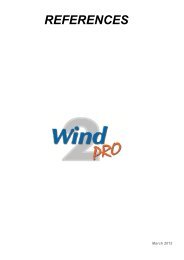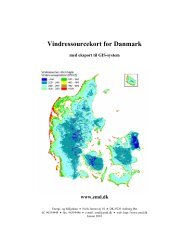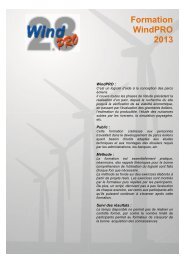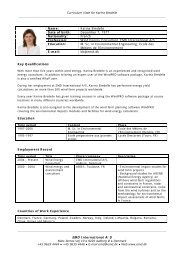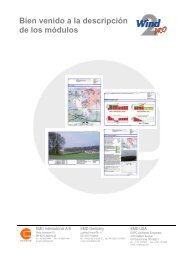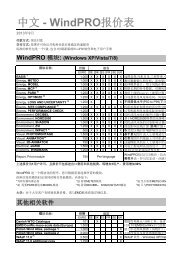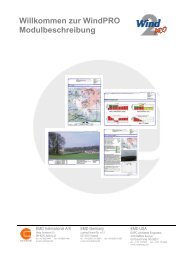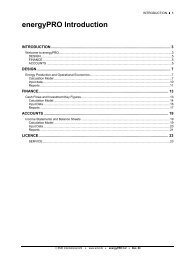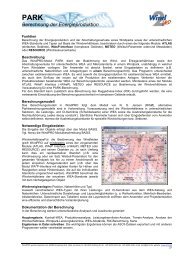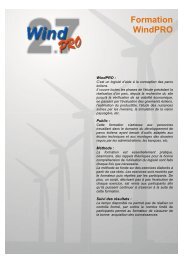Klim, Denmark Case study. - EMD
Klim, Denmark Case study. - EMD
Klim, Denmark Case study. - EMD
Create successful ePaper yourself
Turn your PDF publications into a flip-book with our unique Google optimized e-Paper software.
<strong>Klim</strong>, <strong>Denmark</strong>, CASE - 01<br />
<strong>Klim</strong> Fjordholme, <strong>Denmark</strong><br />
35 Vestas 600 kW, based on 89 days production<br />
100<br />
95<br />
PARK efficiency (%)<br />
90<br />
85<br />
80<br />
75<br />
70<br />
Actual 98-selection Park efficiency based on assumed PARK efficiency.: 89%<br />
Calc.Silstrup 98-selection, WDC = 0.04 (less turbolent)<br />
Calc.Silstrup 98-selection- WDC = 0.075<br />
MEAN 1 2 3 4 5 6 7 8 9 10 11 12 13 14 15 16 17 18 19 20 21 22 23 24 25 26 27 28 29 30 31 32 33 34 35<br />
WTG-number<br />
Here it seem quite clear, that at the northeastern rows (WTG 1-20), use of WDC =<br />
0.04 match very well, while use of WDC = 0.075 mach very well at the southwest<br />
rows.<br />
This is a surprising result. The main wind is from southwest, which means that the<br />
northeast WTGs most of the time are the back row, with most turbulence and<br />
therefore a higher WDC should be a better choice.<br />
The explanation although speculative is probably that there is physics lacks in the<br />
PARK model. That the wind disturbed by the first rows holds less energy than the<br />
model predict – and by coincidence it just match lowering the WDC.<br />
Main conclusion:<br />
Actual production for the entire wind farm is calculated very accurate – but the<br />
interesting part in this case is how the differences among the individual WTGs<br />
production is relative to what the PARK-calculation show with different assumptions.<br />
We here have an almost "unique" test site, total flat and open. The findings are that a<br />
0.075 Wake decay constant, as usually is assumed for "open land", work very well for<br />
the two front rows of WTGs in the main wind direction. Whereas 0.04, as normally is<br />
used for off shore (less turbulent wind, higher reduction) is the better value for the<br />
rows behind. This is very surprising, because the back rows should experience more<br />
turbulence. It looks like the PARK model do NOT work correct at large wind farms –<br />
some "large farm" effects seem not to be taken into consideration. This can have<br />
large influence on the calculations of large off shore wind farms.<br />
Energi- og Miljødata, Niels Jernesvej 10, DK-9220 Aalborg O – Tel: +45 9635 4444, Fax: +45 9635 4446, Mail:<br />
emd@emd.dk, Web: www.emd.dk - 11 -



